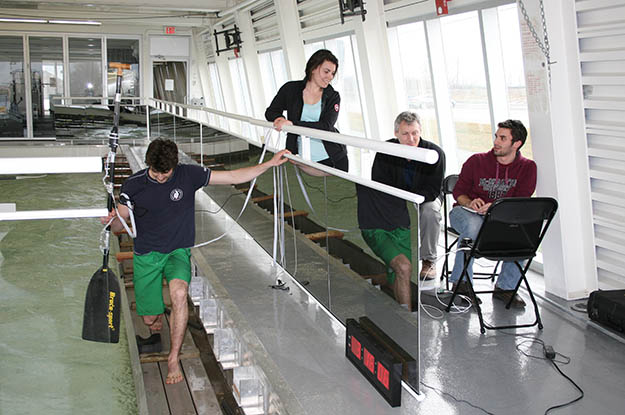Stephen Tullis wants to design the perfect paddle

Experimental work at the Welland International Flatwater Centre done with an instrumented paddle developed by McMaster students Cam Galipeau, Alina Kaas, Lizz Hodgson and Eric Lappalainen. Pictured left to right: Dana Morgoch, Alina Kass, Stephen Tullis and Cam Galipeau.
A McMaster mechanical engineer has paired his knowledge of wind turbines with his rowing background to help build better oars and paddles.
Stephen Tullis, an associate professor and former competitive rower, is contributing to the success of Canada’s rowing and canoe-kayak teams through his research to build better blades for oars and paddles.
Tullis, who has emerged as one of the preeminent experts in this field, worked with Rowing Canada on blade development for the women’s national team for the Summer Olympic Games in London in 2012. He received funding for the research from Own the Podium, a Canadian not-for profit dedicated to developing Canadian athletes.
“In a canoe, or a rowing boat, the interaction of the blade with the water is how the athlete’s power is transformed into boat speed,” says Tullis, who rowed competitively at Cambridge University in England. “Where the blade meets the water is where all the complicated physics and hydrodynamics is going on.”
Tullis’ research was inspired by his scientific study of wind turbines, specifically vertical axis wind turbines, which spin, often eggbeater-style, on a shaft that’s vertical. Most industrial turbines are horizontal with three blades and act relatively predictably, similar to an airplane wing.
By studying these vertical axis turbines, Tullis was able to draw parallels between the fluctuating and unsteady airflows on turbine blades, which act more like insect wings, with his experience on the water using a rowing oar and canoe paddles.
Tullis and his research team model how water flows over blaes and measure the forces on oars and paddles and use the information to design better blades for competitive watersport athletes.
“The fluid dynamics here is really complicated, and understanding the flow lets us design better blades and help the athletes,” says Tullis. “Working on something that would be in the field, new and instrumented blades, is the objective.”
Tullis does some of his research at the state-of-the-art Welland International Flatwater Centre, one of the sites for the Pan Am Games. Tullis is currently pursuing this work with two grad students, including international competitive canoer, Dana Morgoch, using the flume at the centre to conduct tests on canoe paddles.

